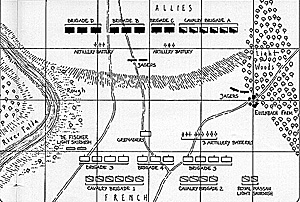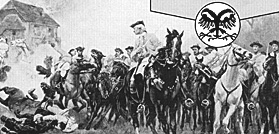The following scenario represents one of the smaller battles of the Seven Years War and can easily be fought to a conclusion in a couple of hours. With the victory conditions used, the scenario gives both sides a good chance of winning.
HISTORICAL BACKGROUND
Duke Ferdinand and the main Allied army drove the French back from the left bank of the Rhine, leaving a small force (under the command of the Prince of Isenburg) on the opposite bank to protect Hesse against French troops operating out of Hanau.
This force was then confronted by a much larger French force under the Prince de Soubise. Isenburg fell back before the French until, under orders from Ferdinand, he decided to make a stand at Sandershausen. The first French formation on the scene was the advanced guard, under the Duke de Brogue.
In the historical battle, after some initial cavalry combats, the French first pushed forward against the Allied flanks. This forced Isenburg to draw troops from his centre to reinforce the flanks, leaving only the militia in the centre. The French then attacked the centre, which collapsed, forcing the Allies to withdraw. Both sided were considered to have fought very well in this battle
VICTORY CONDITIONS
The Allies are substantially outnumbered and victory, therefore, is determined essentially by how quickly the French can force the Allies to withdraw (up to the end of the day, 12 turns). The only terrain feature is Ellenbach Farm which is worth one withdrawal point.
| ? | Incredible Allied Victory |
| French Withdraw | Major Allied Victory |
| Neither Side Withdraws | Minor Allied Victory |
| Allies Withdraw On Turns 10 or 11 | Draw |
| Allies Withdraw On Turns 8 or 9 | Minor French Victory |
| Allies Withdraw On Turns 6 or 7 | Major French Victory |
| Allies Withdraw Before Turn 6 | Incredible French Victory |
Each 10% more casualties inflicted than received will move the scale of victory up or down by one place (e.g. if the French are forced to withdraw and suffer 30% casualties while the allies only suffer 20% then this would mean an Incredible Allied Victory.
SETUP
The map (which assumes a 6' by 4' table) shows the terrain layout and historical troop set up. The French and Allied player, however, are free to set up their troops within the following limitations:The Allies are upslope of the French and there is an escarpment beside the river which is also higher than the French.
| Formed Troops | Up to 12" from own baseline |
| Jagers | Up to 18" from own baseline |
| French Grenadiers | Up to 18" from own baseline |
| Guns | Up to 18" from own baseline |
| All | At least 9" from the edge of the field |
| Allies | May set up 1 Jager unit and 1gun battery in Ellenbach |
The Allied Jagers may be deployed in units of 4, 8 or 12 figures.
 Larger map - very slow (114K)
Larger map - very slow (114K)
Jumbo map - very slow (381K)
RULES
This scenario has been designed around 'Warfare In The Age Of Reason' (with some local changes) but any set of Seven Years War rules can be used with a few amendments. The following notes should help in amending the scenario for other rules:
FIGURE SCALE
Each figure represents 50 men.
A squadron of cavalry is 3 figures strong,
battalion of infantry is 12 figures strong.
GUN SCALE
Each battery represents 4 guns.
MOVEMENT
WAR has fairly fast movement rates with
infantry/ in line covering 6" a move (in 15mm) scale when they do not fire. The victory conditions will have to be altered for rules with faster or slower movement rates.
WITHDRAWAL
There is a specific system within WAR for armies being forced to withdraw from the field. Where another rule set is used conditions for withdrawing must be agreed, I would suggest as a rough guide an army suffering 35% casualties should be forced to withdraw.TROOP CLASSES
The following defines the troop classes used. The figures aRereach class are specifically for WAR and represent (in order) Morale Class (1-4), Fire Class (1-4), Melee Class (1-4) and Manoeuvre Class (1-4):MILITIA (1,1,1,1)
Poor troops unable to fight, melee or manoeuvre effectively & prone to running away.2ND CLASS (1,2,2,1)
Second rate regulars with poor morale but still able to fire and fight effectively.LINE (2,2,2,2)
Normal, regular troops.VETERAN (3,2,2,2)
Above average troops with high morale.ELITE (3,3,3,3)
Highly trained troops with superior fire power, melee capability, morale and manoeuvrability.THE REFIGHT
 In the three times this battle has been fought at
our club, honours have been fairly even. Both
sides have to be careful how they act. If the
French decide to be cautious they are unlikely to
be defeated but have little chance for a major
victory. Being aggressive gives the French the
chance of a major victory but can be exploited
by a cunning Allied commander. The Allied
commander must weigh his options carefully, if
he is entirely passive he will very quickly be
surrounded and overwhelmed. An all out attack,
however, is also unlikely to succeed.
In the three times this battle has been fought at
our club, honours have been fairly even. Both
sides have to be careful how they act. If the
French decide to be cautious they are unlikely to
be defeated but have little chance for a major
victory. Being aggressive gives the French the
chance of a major victory but can be exploited
by a cunning Allied commander. The Allied
commander must weigh his options carefully, if
he is entirely passive he will very quickly be
surrounded and overwhelmed. An all out attack,
however, is also unlikely to succeed.
ALLIED FORCES
CinCPrince Isenburg of Hesse (+2)
| CALVARY | |
| . | |
| Brigade A | |
| lieb Dragoner Regiment | |
| 2 Squadrons | Line Elite |
| Prinz Fredrich Dragoner Regiment | |
| 2 Squadrons | Line Heavy |
| Van Homburg Reg iment Zu Pferda | |
| 2 Squadrons | Line Elite |
| . | |
| INFANTRY | |
| . | |
| Brigade B | |
| Frelwald Freibaffalion | |
| 1 Battalion | 2nd class |
| Grumdlach Land Battlion | |
| 1 Battalion | Militia |
| Wunab land Battalion | |
| 1 Battalion | Militia |
| . | |
| Brigade C | |
| von Lindau Grenadiers | |
| 1 Battalion | Elite |
| Canitz Regiment | |
| 1 Battalion | Line |
| . | |
| Brigade D | |
| Isenburg Regiment | |
| 1 Battalion | Line |
| Blome Land Grenadiers | |
| 1 Battalion | Veteran |
| Garrison Companies | |
| 1 Battalion | 2nd Classe |
| . | |
| ATTACHED | |
| . | |
| Hanoverilan Jagers | |
| 2x4 Figures | Line Irregular Skirmish Rifle |
| Hessian Jagers | |
| 2x4 Figures | Line Irregular Skimish Rifle |
FRENCH FORCES
CinCDuke de Broglie (+2)
| CALVARY | |
| . | |
| Brigade 1 | |
| Apchon Dragoons | |
| 4 squadrons | Line Heavy |
| Rougrade Calvary Regiment | |
| 2 Squadrons | Line Heavy |
| . | |
| Brigade 2 | |
| Royal Allemand | |
| 2 squadrons | Line Armoured |
| Wurttemburg | |
| 2 Squadrons | Line Armoured |
| . | |
| ATTACHED | |
| Royal Nassau | |
| 2 Squadrons | Line Irregular Skimish |
| . | |
| INFANTRY | |
| . | |
| Brigade 3 | |
| de Beavuoisis | |
| 2 Battalions | 2nd Class |
| Rohan | |
| 2 Battalions | 2nd Class |
| . | |
| Brigade 4 | |
| Royal Bavarie | |
| 2 Battalions | Line |
| Royal Deux Ponts | |
| 1 Battalions | Line |
| . | |
| Brigade 5 | |
| von Diesbach | |
| 2 Battalions | Line |
| Waldner | |
| 2 Battalions | Line |
| . | |
| ATTACHED | |
| de Fischer | |
| 1 Battalion | Line Irregular Skimish |
| Waldner | |
| 10 Figures | Veteran Skimish |
2 Batterys Of Light Guns &
1 Battery Of Medium Guns
(with any brigade or independent)
Back to Battlefields Vol. 1 Issue 6 Table of Contents
Back to Battlefields List of Issues
Back to Master Magazine List
© Copyright 1997 by Partizan Press.
This article appears in MagWeb (Magazine Web) on the Internet World Wide Web.
Other military history articles and gaming articles are available at http://www.magweb.com